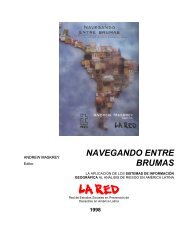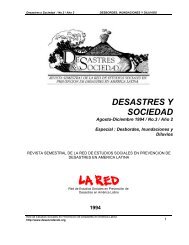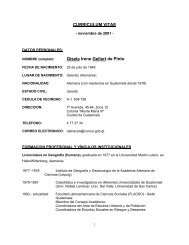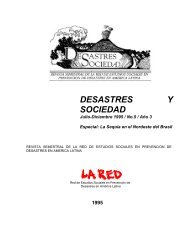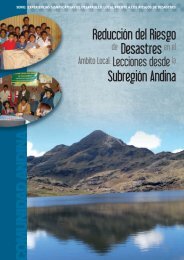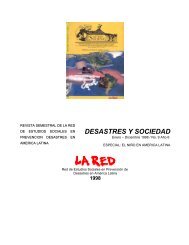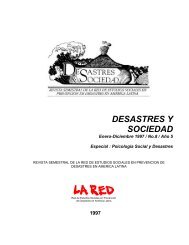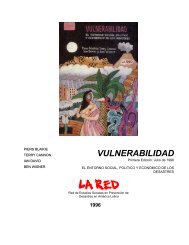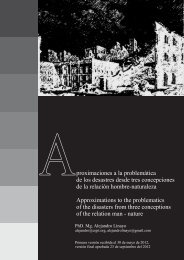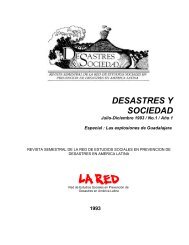Estrategias sociales de prevención y adaptación Social ... - La RED
Estrategias sociales de prevención y adaptación Social ... - La RED
Estrategias sociales de prevención y adaptación Social ... - La RED
Create successful ePaper yourself
Turn your PDF publications into a flip-book with our unique Google optimized e-Paper software.
Introduction<br />
Virginia García Acosta, ciesas, Mexico<br />
<strong>Social</strong> networks, as Sociologist Manuel Castells has pointed out, are as old as humanity<br />
itself; they have recently, however, adopted new forms; they constitute the organizational<br />
structure of our time. 1 A network is a set of interconnected no<strong>de</strong>s; there is no<br />
center to it, only no<strong>de</strong>s through which knowledge is distributed and <strong>de</strong>cisions are ma<strong>de</strong>. The<br />
flexibility and adaptability that are inherent to mo<strong>de</strong>rn networks give them a great advantage<br />
over other, ol<strong>de</strong>r types of organization of a rational and hierarchical nature, Anthony Gid<strong>de</strong>ns<br />
points out. 2 The advances in information and communication technologies have had a<br />
<strong>de</strong>cisive influence on this, minimizing and even eliminating space and time barriers.<br />
It is precisely the <strong>de</strong>ployment of a network, the “Network on risk and vulnerability: social<br />
strategies for prevention and adaptation”, which constitutes the most relevant result of<br />
one of Foncicyt’s successful projects which, having been conceived some four years ago,<br />
reaches its final phase with this publication which we are now putting at the disposal of specialists<br />
interested in the topic.<br />
The invitation ma<strong>de</strong> by the Science and Technology International Cooperation Fund<br />
(Foncicyt, by its Spanish initials), based on the Agreement signed by Mexico’s Conacyt and<br />
the European Union, was published in 2008. It was launched in pursuit of three goals: to<br />
strengthen the scientific capabilities of all participants; to contribute to un<strong>de</strong>rstanding and<br />
therefore enable the generation of proposals aiming to solve problems that are common to<br />
all the international community in connection with environmental and socio-economic<br />
matters; and to promote cooperation between Mexico and the European Union based on<br />
contributions with a local and regional focus. It was implemented through financial support<br />
earmarked for the creation of international networks or for the <strong>de</strong>velopment of research<br />
projects between participating countries.<br />
A group of Mexican social researchers found this invitation to be a valuable opportunity<br />
for launching an ambitious proposal: the constitution of a Mexican-European network of<br />
specialists on risk and disasters, with the specific aim of finding key factors that would increase<br />
the possibility of preventing disasters. One of the central i<strong>de</strong>as of the project was to<br />
make use of existing lessons <strong>de</strong>riving from those practices that have increased the chances<br />
for survival of groups exposed to risk. Few of these have become learned lessons; most of<br />
them have barely been i<strong>de</strong>ntified within so-called comprehensive risk management.<br />
This group, whom we may refer to as the original network, was ma<strong>de</strong> up of three researchers<br />
with heterogeneous professional histories and ages, but who had valuable elements<br />
1<br />
Manuel Castells (2000), <strong>La</strong> sociedad red, Madrid, published by Alianza Editorial.<br />
2<br />
Anthony Gid<strong>de</strong>ns (2009), Sociología, Madrid, published by Alianza Editorial.<br />
17



